
 |
Photo courtesy of the Good Guys at EAA
The flight into Oshkosh was one of the real thrills of my life thus far. Solo out of Memphis under an 800 foot overcast, I flew to Mt. Vernon, Illinois for gas and stopped for the night in Peru.
Calling "Cozyjet over Fond du Lac" and being cleared to Warbird with "Hey the Cozyjet's here!" was a thrill I can't describe. All the time and all the work and I found myself solo with 10 hours in in a new jet about to land in front of a couple thousand people. Nervous? Uh, yeah just a bit!
Sometimes I wonder. N722's original fit was with a Mazda 13B engine from a 1992 RX7 car. With a whole stack of modifications, it's a very smooth and elegant way to turn a propeller. I fundamentally blame Chuck Kerber and his flawless L-39 Albatrosjet for getting me thinking seriously about turbine power. As soon as I got a 100% thumbs down - can't be done - the whole thing is stupid - have your head examined - response from just about everyone, I thought to myself, hmm self, how hard could it really be? Forget the Common Wisdom as really think about it from scratch. Robert thinks it'll work and so do I. The engine's already in the back, and it's just a little engineering, right? If engineering was really hard engineers couldn't do it, right? My friends usually tend to get camcorders and beer at this point ...

There are times when you have to look in the mirror and admit that there are guys with the right stuff and, in this case, you ain't one of 'em. Sucks, but you can't be good at everything I don't think, and a good pilot knows what he can and can't do.
Making the first hop in an experimental jet is no question a job for a professional test pilot and luckily, I have a friend who is one. Len Fox went through a very detailed shakedown that included the canopy popping open and a few other exciting things that your average (or even above average) pilot might not handle with grace and speed.
My take is to never make the first hop in a new machine -- your love for the project will keep you in it long after you should have hit the silk and bailed out. Same reason that first flights should be semi-clandestine -- you don't need an audience when you are working through something you'd hope would never happen. It was TOUGH watching someone else have all the fun, but I got in as soon as Len got the numbers down and haven't gotten out since. Oh yes.
Len climbed out at 3000 feet/minute indicating 150 knots at 85% power on the first hop, and made a better landing than I did in my own plane. Hey, what's with that? The engine idles at 56%, and the power rises nearly exponentially (e to the zoom) from 80% on up. I usually cruise at about 85-90% power and takeoff at full rated (105%) to scream off the deck at 4500 feet/minute looking for blue skies, green pastures, and the elusive $100 tofuburger.
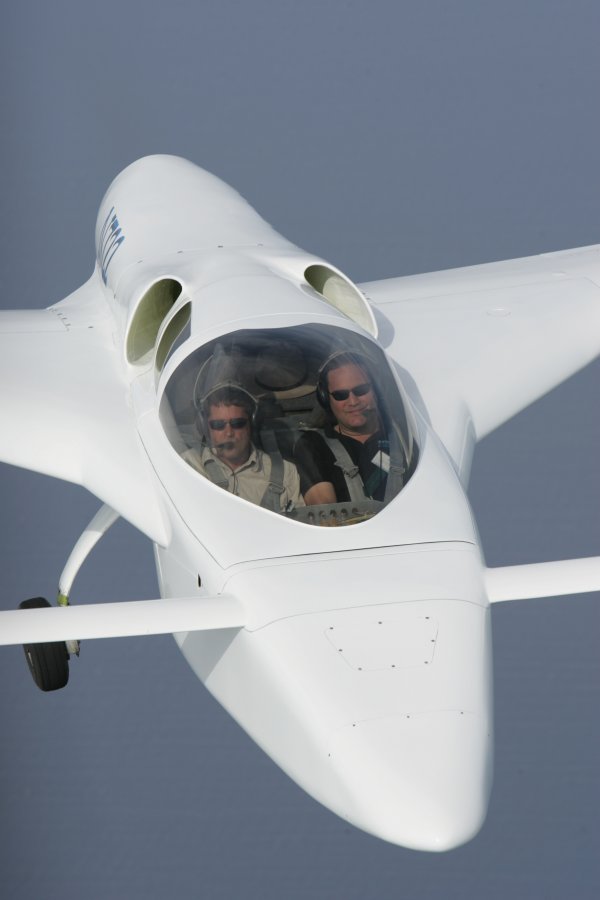 Zooming Over The Lake
Zooming Over The Lake Airspeed here is just under 200 knots indicated (about 230 mph). We are screaming across lake Winnebago near Oshkosh pretending to be serious hombres. This was a photo mission for Sport Aviation magazine and the pics are all courtesy of the Good Guys at EAA. When I told Len we had some formation flying to do he was all about "Yeah, I'm going" and good thing. I hadn't flown tight formation before and you can sure learn a lot from a Navy fighter pilot about flying tight on another ship. The camera ship was a Cessna 210 with the doors off, and we were slow as we could go, they were running flat out and screaming most of the time. It was WILD.
I was secretly hoping for a converted L39 or Iskra, anything with a Red Star on the tail to chase. Hell yeah! It was that kind of day.
Check out the pic and see what happens when you put two big dudes in the plane and why she's called a Cozyjet. Well, 722 was designed was for a smaller and more delicate co-pilot anyway. No offense, bro'!
Note: The Blue Brothers Go Flying look wasn''t intentional. Man, have I caught hell about that pic ...
The General Electric T-58 is a turboshaft engine that turns the blades on Sea King choppers among other things. By removing the N2 section and fitting a tailcone, you end up with a gas producer that is loud enough to not only wake the dead, but have 'em calling The Law.
The T-58 conversion is, as anyone can tell you who's heard one run, insanely loud. After much theorizing and hanging about we came up with a reasonable understanding of why it's so loud, and Tom Lloyd (RV driver and fellow engineer) figured out how to best remove the exhaust screech, and Robert Harris' fiberglass S Duct intake took care of the compressor noise.
The hush kit has got the sound level down to about where a Citation is at idle, although there's no hiding the flow noise on takeoff (whooooosh!). I thought 722 was destined to be the noisiest kid on the ramp, but with a little engineering, and more than a little help from my friends, she's sounds like just another
Bizjet. The cone and tailpipe were laser cut, rolled and welded by Brad Snodgrass, a fellow EFIS driver and an RV builder who also happens to be in the metals business (talk about luck). Brad figured the optimal alloy on the price/temperature curve to be Hastex, which is a swoopy high temperature stainless steel.
To answer the obvious question, of WTF were we thinking, and how I got it all done, I'll defer to my ace mechanics: Robert and Valerie Harris who did the cutting, welding and splacking to turn my Clark Kent Cozy into the iron-pumping beast she is this week. They've got another LongEZ going through -The Transformation- to burn Kerosene, and are talking about building several more now that the first one actually worked (hey, wait a sec ...). Robert is the DAR and composite wizard, Valerie is the IA and, well, OK she did a ton of composite work too. I did the electronics, as you'd expect, and they all worked the first time no smoke, no troubles (as I'd expect!). They're both damn good mechanics, good folks, and patient as hell (they put up with me for a year without bloodshed, 'nuff said). They're shop is in Covington, TN about an hour drive outside Memphis. If you feel the need for speed and want to convert your canard pusher into a canard rocket, give 'em a buzz at 901/475-3686 and they'll set you right up.
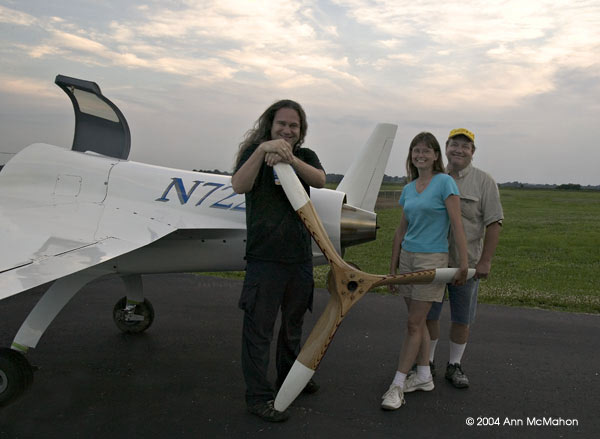 This picture is courtesy of Ann McMahon,Professional Publications, Baton Rouge, LA.
Ann is a LongEZ driver and her a camera has more knobs and gizmos than my airplane!
Scary thing is she uses 'em all ... Ann was gracious enough to be there for first flight day while I was trying to stay cool in the Memphis sun. Notice everyone's in shorts while your intrepid scientist is doing his MIB thing? Memphis is hot. In August it's like Hell's Demo. Bring shorts, shades and enough water to drown a camel. I have no idea how Valerie does it. At least Rob's got a hat!
This picture is courtesy of Ann McMahon,Professional Publications, Baton Rouge, LA.
Ann is a LongEZ driver and her a camera has more knobs and gizmos than my airplane!
Scary thing is she uses 'em all ... Ann was gracious enough to be there for first flight day while I was trying to stay cool in the Memphis sun. Notice everyone's in shorts while your intrepid scientist is doing his MIB thing? Memphis is hot. In August it's like Hell's Demo. Bring shorts, shades and enough water to drown a camel. I have no idea how Valerie does it. At least Rob's got a hat!
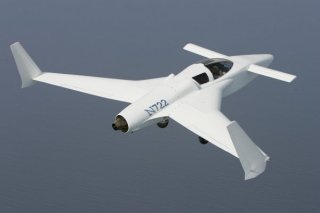
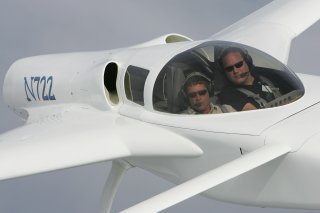
Of course the sole flying example and all known, planned jet canards fly my blue mountain EFIS. Goes without saying, right?

Most jets are comlicated machines with long checklists. We all tried very hard to make 722 easy to fly and easy to operate. Note the serious lack of breakers, switches and the usual frankenstein collection of electrical yeehah. The PC board at the back handles switching, lighting, current limiting, fusing, pitch and roll trim, flaps (speed boards in my case), canopy alarm and, well, essentially the whole airplane electrical system. Makes it simple. Len noted that it was the easiest plane to operate he's ever flown -- throw the switch and go. 722's checklist is actually shorter than a single engine Cessna's! Everything's automatic, even the fail-safes. The board in the pic was a prototype, the one flying in 722 has 6 switched circuits, 10 filtered avionics circuits and 5 master circuits, all individually protected. We got them available now, and the guys who are using them seem to be well pleased. Yup, I'm at it again making new stuff!

Sport Aviation magazine is pretty much it for us homebuilder types, and the November, 2005 issue had a big spread in it on my favorite airplane. Many thanks to Amy Laboda for making me look a lot more interesting than I am, and for writing a truly outstanding tech article. Maybe she'll get enough people fired up that we'll see some more homebuilt jets soon.
Not that anything ever stands still, here's a pic of the latest upgrade: swoopy new paintwork from Flat Top Dave of Custom Hot Rod in Atoka, Tennessee and Mike Low's custom not-exactly-leather interior. These guys do really outstanding work, as you can tell. I thought I was a pretty good bodyman. Really, I did until I saw what Dave did with Kersosene Dreams. The colors don't show well on the Web, but there are SIX (6) colors in the name. The body paint is white Jet-Glo, wet sanded with 600 then coverd in two coats of clear. A lot of work, but she's all pretty now.
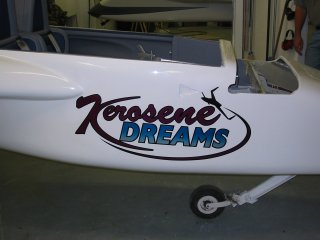 |
 |
 |
 |
Now that 722's all wrapped up and headed for adventures unknown, now what? Well, the rumor is true. We're building another jet. Hey, if Cessna can do the VLJ thing, why not us? VVLJ, maybe?
Andrews-Murphy Airport (KRHP) is 5500 feet long and is inside a box canyon. 722 sleeps there, and although Copperhill (1A3) is closer, Andrews is much longer and the folks at the FBO are pretty cool. Lemme know if you're flying this way.

| Home | P l a n e | P r o j e c t s | S C P & L | A n i m al s | G a r d e n | O p i n i o n s | P h o t o s |
Copyright 1996-2005, Poosty, Woosty and Camo --
The Cats.
All rights reserved.